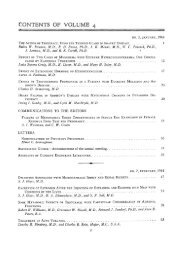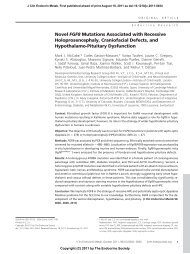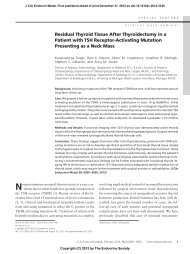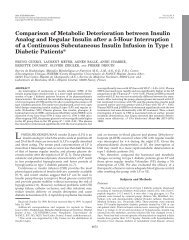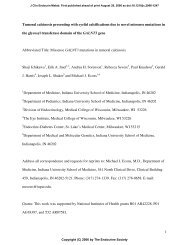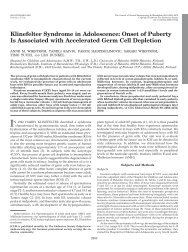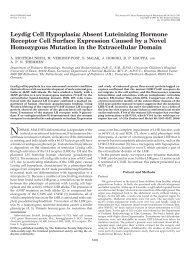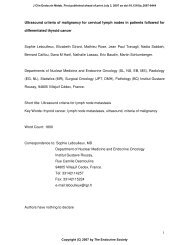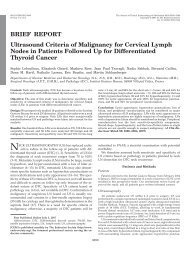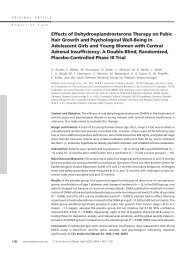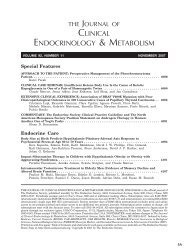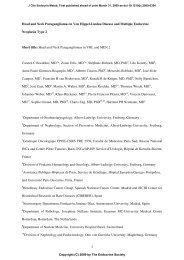Treatment - The Journal of Clinical Endocrinology & Metabolism
Treatment - The Journal of Clinical Endocrinology & Metabolism
Treatment - The Journal of Clinical Endocrinology & Metabolism
You also want an ePaper? Increase the reach of your titles
YUMPU automatically turns print PDFs into web optimized ePapers that Google loves.
J Clin Endocrinol Metab, October 2009, 94(10):3700–3707 jcem.endojournals.org 3705<br />
the follow-up period, but one patient was subject to orbital<br />
decompression surgery (in group I). No significant<br />
differences were found between the different centers for<br />
worsening or development <strong>of</strong> TAO or the severity <strong>of</strong> hyperthyroidism<br />
using the Cox test (results not shown).<br />
During the first 12 months <strong>of</strong> follow-up, 87.7% <strong>of</strong> the<br />
patients in group I and 86.0% in group M had no recorded<br />
serum TSH above 4.5 mIU/liter. Worsening or development<br />
<strong>of</strong> TAO was in a Mantel-Haenszel analysis not found<br />
to be more frequent in the patients who at any occasion<br />
had serum TSH above 4.5 mIU/liter (P � 0.49).<br />
Discussion<br />
Radioiodine treatment was shown to be associated with a<br />
higher cumulative incidence <strong>of</strong> worsening or development<br />
<strong>of</strong> TAO compared with medical therapy. In this study,<br />
L-thyroxine therapy was introduced early in both treatment<br />
groups to avoid hypothyroidism, which was in contrast<br />
to the previous report by Tallstedt et al. (2). <strong>The</strong> time<br />
for active follow-up by ophthalmologists was longer in the<br />
present study compared with the two previous large prospective<br />
randomized trials where radioiodine and medical<br />
therapy were compared (2, 11). In the present study, the<br />
proportion <strong>of</strong> worsening or development <strong>of</strong> TAO after<br />
1-yr follow-up was 31% in the iodine-131 group and 16%<br />
in the medical treatment group. <strong>The</strong> corresponding figures<br />
were similar in Tallstedt et al. (2) (33 and 10%, respectively)<br />
but lower in Bartalena et al. (11) (15 and 3%,<br />
respectively).<br />
In contrast to the results in Bartalena et al. (11), the<br />
differences in the ophthalmological outcome between the<br />
treatment groups in the present study were explained by de<br />
novo development <strong>of</strong> TAO and not by worsening <strong>of</strong> preexisting<br />
TAO. This may partly be explained by differences<br />
in the study designs. In this study and that by Tallstedt et<br />
al. (2), only newly diagnosed patients with Graves’ disease<br />
were randomized, whereas in the study by Bartalena et al.<br />
(11), 70% <strong>of</strong> all patients had a previous history <strong>of</strong> treatment<br />
<strong>of</strong> Graves’ disease. Also, in the latter study a 3-month<br />
course <strong>of</strong> antithyroid drugs was part <strong>of</strong> the protocol for<br />
those treated with radioiodine. In the present study and in<br />
that by Tallstedt et al. (2), TAO was present at randomization<br />
in 13% <strong>of</strong> the patients, whereas this number was<br />
50% in the study by Bartalena et al. (11). <strong>The</strong> discrepancy<br />
in incidence data between this and previous studies may<br />
also be explained by patient characteristics, sample size,<br />
treatment practice, the assessment <strong>of</strong> TAO, and thresholds<br />
for introducing steroid treatment.<br />
It is well known that radioiodine treatment leads to a<br />
prolonged release <strong>of</strong> TRAb and thyroid peroxidase antibody,<br />
but the mechanism for this is not known. <strong>The</strong> rise in<br />
serum antibodies against thyroid antigens after radioiodine<br />
treatment mirrors an immune reaction in the thyroid<br />
that may be the triggering event for the orbital inflammation,<br />
assuming that the thyroid and orbital tissues share<br />
resembling antigens (9, 12–17).<br />
To the patients who were randomized to medical therapy,<br />
L-thyroxine was given early by routine to achieve a<br />
stable thyroid function and because previous studies have<br />
shown that a more severe and unstable Graves’ disease is<br />
a common denominator for the development <strong>of</strong> TAO (2,<br />
9). Furthermore, the potential benefits on the immune system<br />
by antithyroid drugs need to be pointed out (18–21).<br />
If applicable for the present, such influences on the immune<br />
system may have contributed to the lower frequency<br />
<strong>of</strong> worsening or development <strong>of</strong> TAO that was observed<br />
in the medically treated group.<br />
Smoking is an established risk factor for TAO, and this<br />
relationship was also confirmed in this study (22, 23).<br />
Interestingly, in the group <strong>of</strong> smokers, worsening or development<br />
<strong>of</strong> TAO was not significantly associated with<br />
the choice <strong>of</strong> treatment for hyperthyroidism. This infers<br />
that radioiodine may be an independent risk factor for<br />
TAO and that this treatment-related risk factor is not as<br />
strong in smokers as in nonsmokers. However, because<br />
smokers who received radioiodine had the overall highest<br />
risk <strong>of</strong> TAO, one might argue that radioiodine should be<br />
avoided in smokers or be given together with immunesuppressive<br />
prophylaxis.<br />
Prophylactic steroid treatment has been shown to significantly<br />
reduce the risk for TAO in radioiodine-treated<br />
patients (11, 24). However, there have been discussions<br />
about whether the eye changes observed after radioiodine<br />
treatment warrant the use <strong>of</strong> prophylactic steroid treatment<br />
as a rule (25–27). In this decision making, there is to<br />
date no solid agreement about what risk factors should be<br />
taken into account. Smoking habits and preexisting TAO<br />
should probably be regarded, but presumably other possible<br />
risk factors should also be considered, e.g. pretreatment<br />
serum T 3 and antithyroid antibodies (28, 29). <strong>The</strong><br />
high proportion <strong>of</strong> de novo development <strong>of</strong> TAO in the<br />
iodine-131 group implies that other factors besides clinically<br />
apparent preexisting TAO should be considered in<br />
the decision making regarding steroid prophylaxis in patients<br />
who are treated for newly diagnosed Graves’<br />
hyperthyroidism.<br />
This present trial has both strengths and limitations.<br />
<strong>The</strong> prospective randomized design, although open-label,<br />
and the extensive follow-up time by both thyroidologists<br />
and ophthalmologists strengthens the observations. Even<br />
if the final study group did not meet the requisite <strong>of</strong> the<br />
trial, the number <strong>of</strong> 313 patients makes this trial one <strong>of</strong> the<br />
largest on the issue. Surgery was not included as a third



